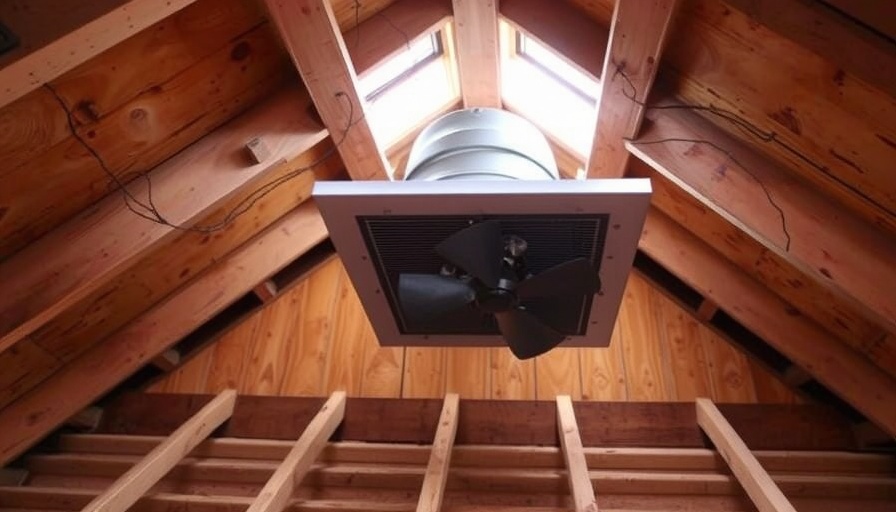
Understanding the Importance of Proper Exhaust Venting
Venting an exhaust fan through your attic is more than just a functional necessity; it plays a vital role in enhancing home efficiency and ensuring indoor air quality. If your home employs an exhaust fan in spaces like kitchens or bathrooms, you might be familiar with the unpleasant moisture and odors they can trap. Proper venting alleviates these issues, directing unwanted air outside and preventing mold growth. Proper installation can significantly impact your home’s longevity and comfort by controlling humidity levels and preventing buildup.
Step-by-Step Guide to Venting Through an Attic
The process begins with determining the best location for your exhaust fan. Ideally, fans should be placed above areas that produce moisture—like above the stove or shower. Next, measure the distance from the fan to the chosen exit point in the attic ensure it's as short as possible to maximize efficiency.
Start by selecting the right duct material. Flexible ducting is generally easier to install, but rigid metal ducts are usually more effective for ventilation due to less resistance—making them more durable for the long run. Secure your chosen duct to the vent and route it toward the attic exit. A critical point during installation is ensuring that the duct slopes slightly upwards to prevent any condensation from remaining inside it. This will keep your ventilation system efficient and help maintain a dry attic space.
Common Mistakes to Avoid
While venting through an attic can seem straightforward, many homeowners make simple mistakes that can lead to significant problems. One common error is failing to ensure that the exit point is in the right location—ideally, it should vent out through the roof or gable, not just into another attic space. Another is neglecting to insulate the ductwork. This failure can lead to condensation inside the duct, resulting in water damage.
Moreover, using duct tape to seal joints can lead to leaks over time because it degrades with exposure to heat and moisture. Instead, embrace metal tape, which is more resilient. Always remember to check local building codes to avoid legal pitfalls!
The Impact of Weather on Exhaust Systems
Different seasons can influence your exhaust fan's performance. In winter, for instance, any moist air vented outside could rapidly condense, leading to ice forming in your ducts. This could eventually block airflow or create pressure issues inside your system. Therefore, using the appropriate vent caps equipped with backdraft dampers is essential. These devices close when the fan is off, preventing cold air from entering the ductwork.
Let’s Talk About Maintenance
A great exhaust system doesn’t just need proper installation; it requires ongoing maintenance to ensure it operates smoothly over time. Periodic inspection and cleaning of your ducts keep any debris build-up at bay, promoting airflow and reducing the risk of fire hazards. Clean your fan blades regularly to avoid strain during operation. A well-maintained fan can operate efficiently for years without needing replacement.
Cost Considerations for Your Project
While DIY projects can initially seem like a cost-saving avenue, it's wise to factor in your time and the potential cost of errors—especially with something as vital as ventilation. Hiring professionals can streamline the process and ensure everything is up to code, saving you money on repairs and energy bills in the long run. Costs may vary, depending on duct material, labor, and additional features like dampers.
Real-Life Success Stories
Residents across neighborhoods have successfully increased their home’s comfort by engaging in DIY venting projects. One homeowner in our local community mentioned how they took the initiative to consult with experts and felt empowered to approach the project confidently.
By sharing these inspiring project stories, we can motivate others to consider improvements in their own homes, fostering a community centered around self-sufficiency and shared knowledge.
Conclusion: Empower Your Home Improvement Journey
Understanding how to vent an exhaust fan through an attic isn’t just a project; it can enhance your home's efficiency and comfort significantly. By following a proactive approach and avoiding common pitfalls, your exhaust system can serve you well for years to come. Don't hesitate to reach out to professionals if you feel uncertain about the installation process, and always stay informed about local codes and methods.
For more insights into home improvements, join us on our podcast and explore our YouTube channel where you’ll find tutorial videos guiding you through similar projects!
 Add Row
Add Row  Add
Add 



 Add Row
Add Row  Add
Add 
Write A Comment